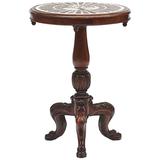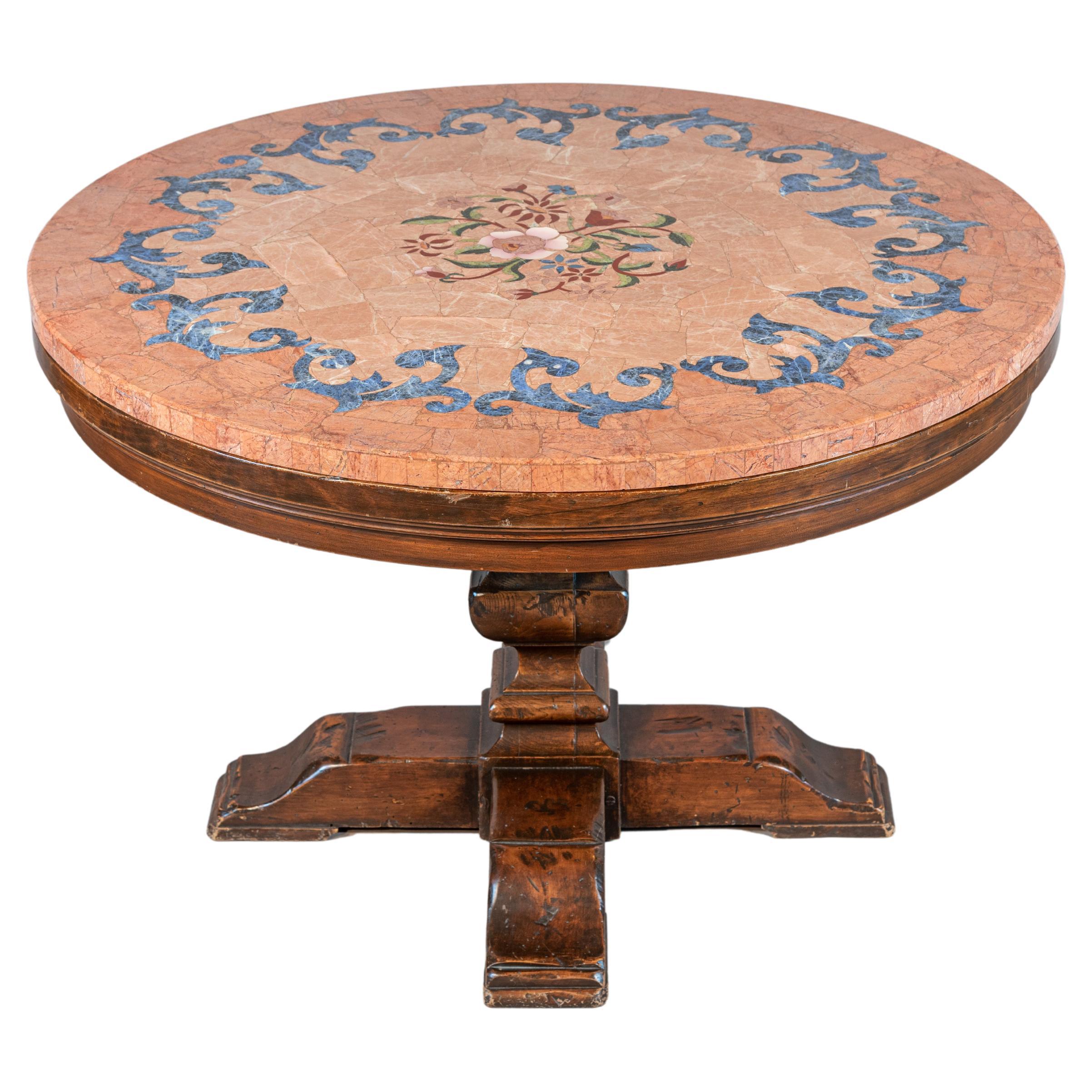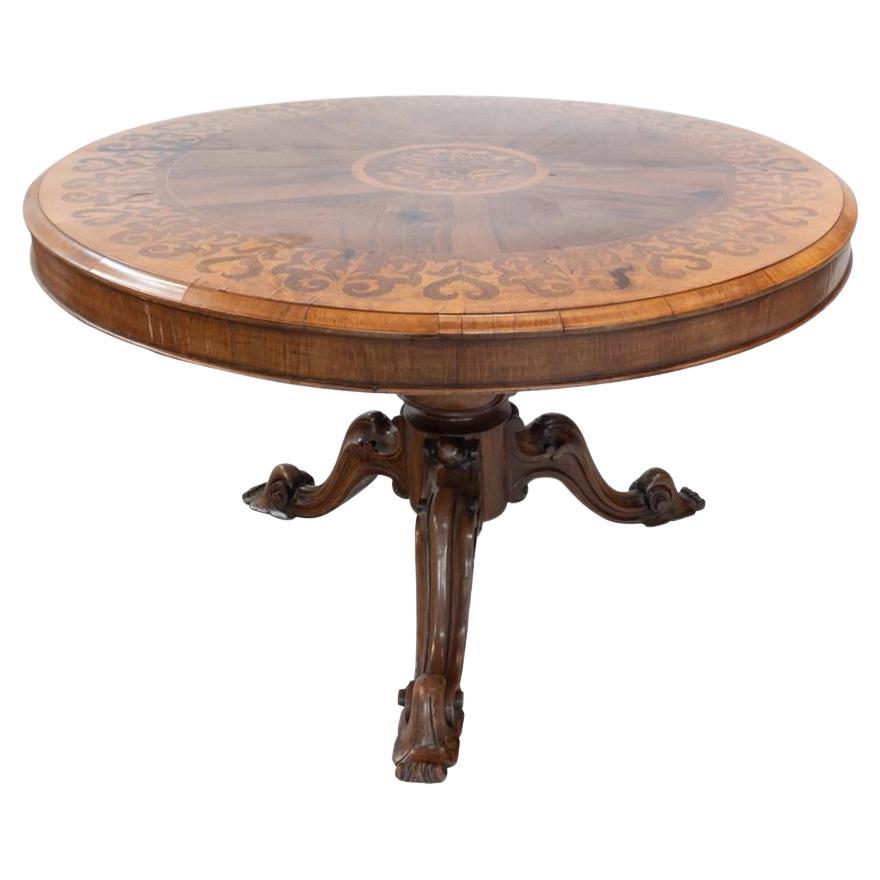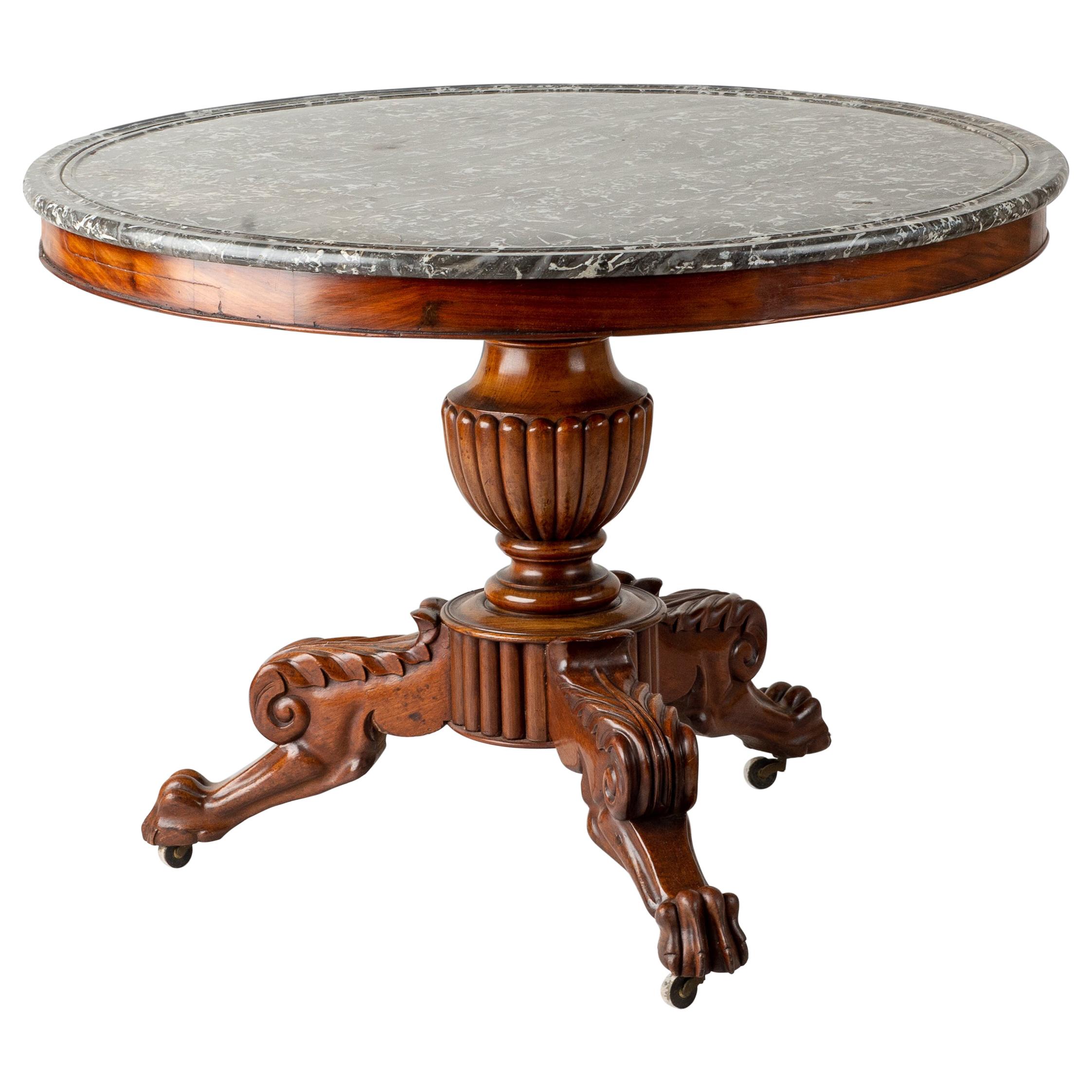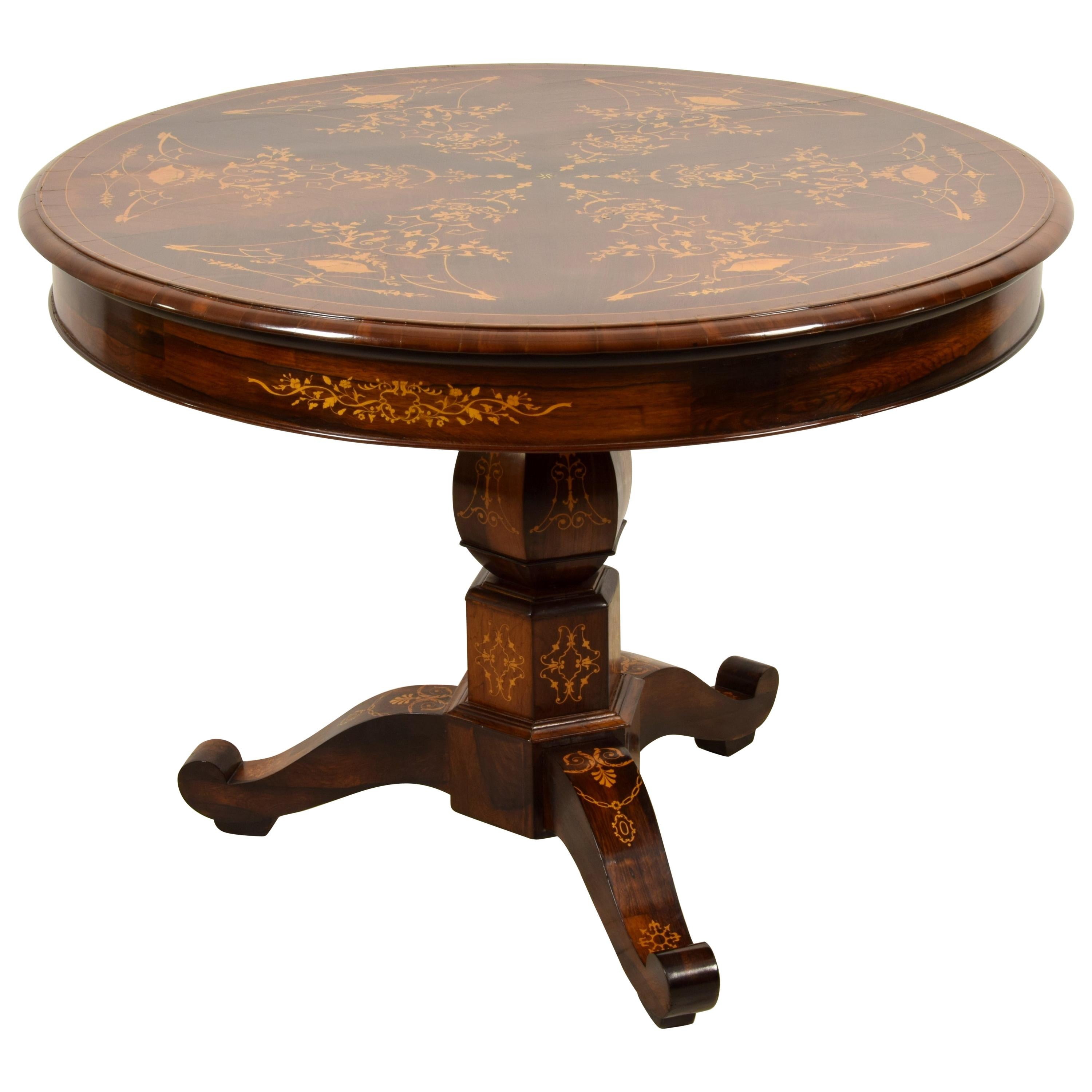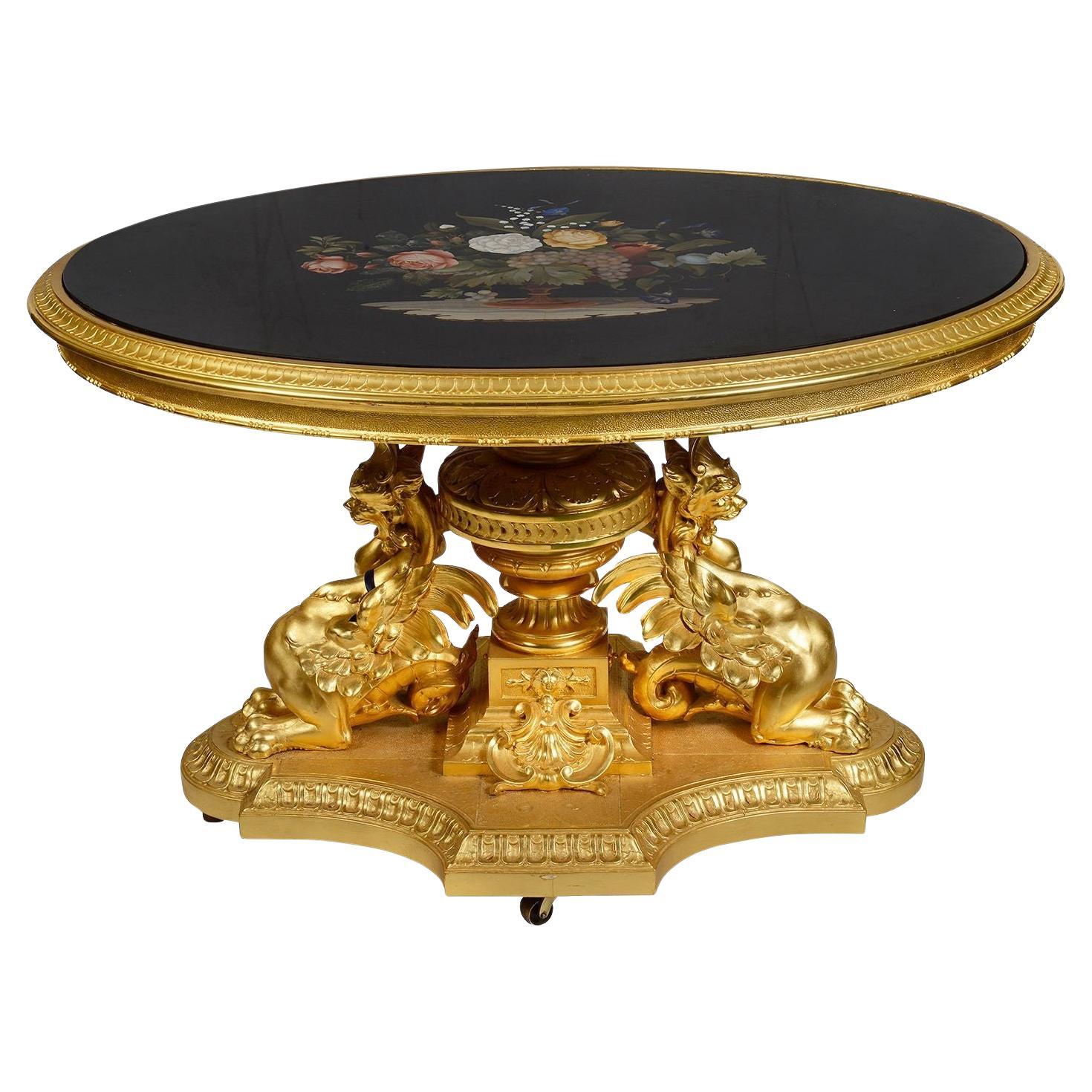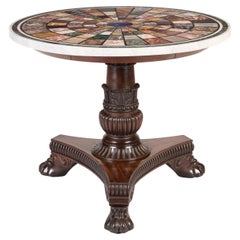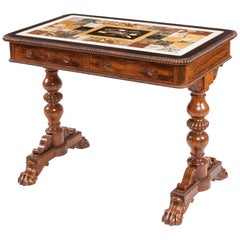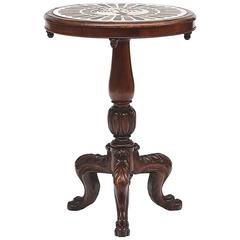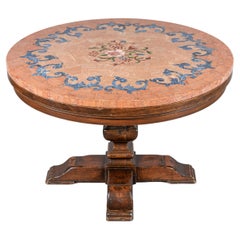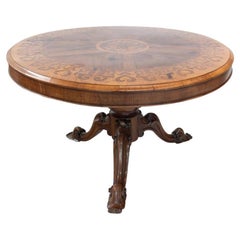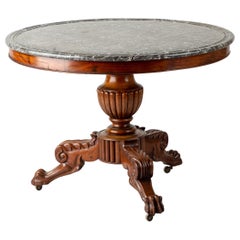Items Similar to 19th Century Irish Table with Marble-Inlaid Top having Aristocratic Coat of Arms
Want more images or videos?
Request additional images or videos from the seller
1 of 9
19th Century Irish Table with Marble-Inlaid Top having Aristocratic Coat of Arms
$78,999.45
£58,000
€67,981.55
CA$110,561.07
A$121,221.49
CHF 63,300.91
MX$1,458,748.49
NOK 797,807.04
SEK 750,143.83
DKK 507,696.27
About the Item
The Specimen Pietra Dura Marble Armorial Top
By Joseph Darmanin of Malta
The shaped circular top finely inlaid with the arms of General Robert Edward King, 1st Viscount Lorton (1773-1854), masterfully executed in pietra dura and specimen marbles upon a fossil-rich yellow marble ground. The inlaid work is of exceptional delicacy, having all the hallmarks of the greatest heraldic tops by the famous makers, including the use of delicate shaded marbles.
The richly carved base, unmistakably Irish in conception and executed in dense, darkly patinated mahogany, is by Strahan of Dublin, one of the foremost cabinetmakers of his day. The double C-scrolled tripartite base enriched with carved flowers leading to the acanthus clasped pedestal support, on brass hidden castors.
The frame stamped 'Strahan' and retaining its original paper label from Strahan's Henry Street workshop. The underside of the marble top equally bearing its original trade label of 'J. Darmanin & Sons […] Malt.'
The base, Irish, circa 1835
The top, Maltese, circa 1830
Provenance
Commissioned by General Robert Edward King, 1st Viscount Lorton
Originally housed in the Billiard Room at Rockingham House, Co. Roscommon
By descent through the King-Harman family
Lady Dunn
Thence by descent
Private Collection, UK
Dimensions: H: 29 in / 74 cm Dia: 38 in / 97 cm
This table was most likely acquired by Lord Lorton on one of his Grand Tours-either in 1825 or 1836-aligning with Darmanin's transition to "& Sons." The Irish base, dated slightly later, suggests the top was mounted upon return, a common practice for souvenirs of elite European travel. The table remained at Rockingham House until its mid-20th-century demolition, a rare survivor from what was once considered John Nash's finest classical house in Ireland.
J. Darmanin & Sons of Malta
The renowned 'Marble Workers Darmanin' were Malta's leading marble craftsmen in the 19th century. They excelled in creating 'Monumental and Mosaic Slabs and other Decorative Artworks,' notably mosaic table tops primarily for export. Founded by Giuseppe Darmanin (later stylised as Joseph) around 1800, their work was cherished by British tourists like Sir Moses and Lady Montefiore, who visited Valletta during their Levantine Grand Tour in the 1830s.
Darmanin's impressive marble mosaic tables gained international acclaim through several international exhibitions from 1851 to 1886. Notably, a table currently exhibited at Buckingham Palace was presented at the Crystal Palace in 1851, where the Darmanins were awarded a prize medal.
Robert Strahan & Co
The furniture firm of Robert Strahan and Co was founded in 1776. Operating from premises in 10-11 Chancery Lane, by 1815 it was so successful that two new workshops opened at 24-25 Henry Street and 5 Leinster Street in 1845. They displayed their work at Dublin's great industrial exhibition of 1853, where the best examples of Irish design and manufacture were on show. In 1870 the firm moved to Abbey Street and continued to trade under the well-established family name up until 1969.
Patronized by the Office of Public Works, the firm designed and manufactured high quality pieces. A walnut table exhibited at the second London International Exhibition of 1862, showed the influence of designers such as Thomas Hope (1769-1831) and Richard Bridgens (1785-1846). Illustrated in the Art Journal Illustrated Catalogue for the London exhibition, the table was heavily decorated with intricate marquetry, scrolling foliage, masks, strap work and cartouches.
Ref. 9882
- Creator:Robert Strahan (Cabinetmaker),J. Darmanin & Sons (Maker)
- Dimensions:Height: 29 in (73.66 cm)Diameter: 38 in (96.52 cm)
- Style:William IV (Of the Period)
- Materials and Techniques:
- Place of Origin:
- Period:
- Date of Manufacture:circa 1835
- Condition:Wear consistent with age and use.
- Seller Location:London, GB
- Reference Number:Seller: 98821stDibs: LU954746345752
About the Seller
5.0
Recognized Seller
These prestigious sellers are industry leaders and represent the highest echelon for item quality and design.
Established in 1964
1stDibs seller since 2012
54 sales on 1stDibs
Typical response time: 1 hour
Associations
The British Antique Dealers' AssociationLAPADA - The Association of Arts & Antiques Dealers
- ShippingRetrieving quote...Shipping from: London, United Kingdom
- Return Policy
Authenticity Guarantee
In the unlikely event there’s an issue with an item’s authenticity, contact us within 1 year for a full refund. DetailsMoney-Back Guarantee
If your item is not as described, is damaged in transit, or does not arrive, contact us within 7 days for a full refund. Details24-Hour Cancellation
You have a 24-hour grace period in which to reconsider your purchase, with no questions asked.Vetted Professional Sellers
Our world-class sellers must adhere to strict standards for service and quality, maintaining the integrity of our listings.Price-Match Guarantee
If you find that a seller listed the same item for a lower price elsewhere, we’ll match it.Trusted Global Delivery
Our best-in-class carrier network provides specialized shipping options worldwide, including custom delivery.More From This Seller
View All19th Century 'Grand Tour' Marble Top Table with Base attributed to Trotter
By William Trotter
Located in London, GB
An Impressive 'Grand Tour' Specimen Marble Top Centre Table
The base attributed to William Trotter of Edinburgh
Constructed in a finely patinated mahogany, with a Florentine Pietra ...
Category
Antique 19th Century Italian Grand Tour Center Tables
Materials
Agate, Lapis Lazuli, Malachite, Marble, Breccia Marble, Porphyry
19th Century Shaped Centre Table with Inlay and Gilt Metal by Gillows
By Gillows of Lancaster & London
Located in London, GB
An Antique Shaped Centre Table by Gillows
Constructed in Circassian walnut, with specimen woods inlays, and gilt metal adornments; rising from a castor sho...
Category
Antique 19th Century British Victorian Center Tables
Materials
Metal
19th Century Gueridon Centre Table with Sèvres Style Porcelain Panels
Located in London, GB
A superb gueridon centre table.
with sèvres style porcelain panels.
Constructed from bois noirci and kingwood with mercury fire gilded ornament, the central support rising from a...
Category
Antique 19th Century French Center Tables
Materials
Ormolu
19th Century Georgian Table with Italian Pietra Dura and Specimen Marble Top
By Gillows of Lancaster & London
Located in London, GB
A late Georgian table in the Gillows manner
Constructed in goncalo alves, having an inset Florentine Pietra Dura platform; of free-standing, turned and tapering end support form, wi...
Category
Antique 19th Century English George IV Tables
Materials
Lapis Lazuli, Marble, Siena Marble
19th Century Italian Pietra Dura Hardstone and Giltwood Table
Located in London, GB
An Italian Pietra Dura top occasional table
Constructed in carved gilt wood, having an unusual pietra dura inlaid rectangular platform; the table's legs terminating in scrolls, wi...
Category
Antique 19th Century Italian Grand Tour Side Tables
Materials
Onyx, Marble, Carrara Marble, Porphyry
19th Century William IV Period Mahogany Centre Table Attributed to Gillows
By Gillows of Lancaster & London
Located in London, GB
A William IV Period Mahogany Centre Table
Attributed to Gillows
Constructed from a flamed Honduras Mahogany, book-matched with great effect on the top; the table supported on an inc...
Category
Antique 19th Century English William IV Center Tables
Materials
Mahogany
You May Also Like
Early 19th Century George III Marble-Top Inlaid Mahogany Table
Located in Dublin 8, IE
Early 19th century George III marble-top inlaid mahogany table, with stone mosaic depicting two birds in a tree, above turned central pillar on tri...
Category
Antique Early 1800s Irish George III End Tables
Materials
Marble
19th Century French Center Table Brazilian Marble
Located in Austin, TX
Transport your living space to the opulence of the 19th century with this exquisite French center table, a true embodiment of timeless elegance. Crafted with meticulous detail, the t...
Category
Antique 19th Century French Louis Philippe Center Tables
Materials
Marble
$3,674 Sale Price
25% Off
Antique English William IV Center Breakfast Table w/ Marquetry Inlay Circa 1900
Located in Los Angeles, CA
Circa 1900 Antique William IV Round Pedestal Center / Breakfast Table. Constructed with mahogany, rosewood, satinwood with intricate marquetry and inlays to table top, rising on a ca...
Category
Antique Early 1900s British William IV Center Tables
Materials
Hardwood, Ebony, Satinwood, Walnut, Rosewood
Early 19th Century French Marble Topped Gueridon Table
Located in Shrewsbury, GB
An early 19th century French marble topped gueridion table, retaining the original marble top with its moulded edge. The table has a cuban mahogany base, with a reeded vase column an...
Category
Antique Late 19th Century Rococo Revival Center Tables
Materials
Marble, Brass
19th Century French Charles X Paved and Inlaid Centre Table with Round Top
Located in IT
19th century French Charles X paved and inlaid centre table with round top
Elegant central table made in France in the Charles X period, paved with different woods. The circular pla...
Category
Antique 1820s French Charles X Center Tables
Materials
Wood
19th century Florentine Pietra Dura inlaid centre table
Located in Brighton, Sussex
This exquisite Italian 19th-century centre table features a Florentine carved giltwood frame and stunning Pietra dura marble inlay top. The or...
Category
Antique 19th Century Italian Neoclassical Revival Center Tables
Materials
Marble
